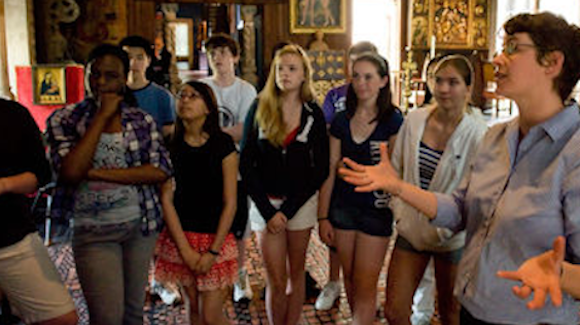
Kids visit a museum
Recently, a study and report was released from the National Art Education Association (NAEA) and the Association of Art Museum Directors (AAMD) which shows that facilitated classroom visits to an art museum had a measurable impact on key aspects of student learning. The study, conducted over a four-year period, involved more than 2,600 students in grades 4 through 6, and included facilitated experiences at six art museums across the United States: Columbus Museum of Art, Hammer Museum, Museum of Fine Arts, Houston, Orlando Museum of Art, Rhode Island School of Design Museum, and Walters Art Museum. Titled the “Impact of Art Museum Programs on Students Research Study,” the results demonstrate that there are a variety of educational benefits to classroom visits to art museums, across four areas:
QUESTIONING
As students observe works of art, they formulate questions and practice key critical thinking and communication skills. Inquiry-based approaches prompt student dialogue that activates collaborative learning and demonstrates how questions function as tools to surface meaning. This study shows that facilitated engagement with original works of art in an art museum has a strong impact on students, inspiring them to question, understand, and investigate.
MULTIPLE INTERPRETATIONS
A facilitated, inquiry-based single-visit art museum program can encourage students to practice listening and respectful debate and discover different interpretations of art objects.
EMOTIVE RECALL
The emotional impact of first-hand encounters with works of art in a museum setting can inspire greater recall and more detailed description, which can lead to more complex interpretations.
Deborah Reeve, Executive Director of the NEA, states, “Facilitated museum experiences inspire students to look closely, and as they do, they wonder, explore, share ideas, and discover personal connections. Facilitated single-visit art museum programs that use inquiry and discussion-based teaching practices also stimulate and foster students’ creativity and curiosity,” But then she adds, “These findings are consistent with the work that art museums do with audiences of all ages and abilities, from young children with autism to aging Alzheimer’s patients, to doctors and detectives who use artworks as study materials. Practicing skills such as observation across a variety of learning environments clearly has the potential to contribute to meaningful cognitive gains.”
So, this four-year nation-wide study seems to show that students in grades 4 through 6 learn the same stuff as anyone of any age. Or maybe it just compares elementary school students to people that turn to art, such as “young children with autism to aging Alzheimer’s patients, to doctors and detectives who use artworks as study materials.”


